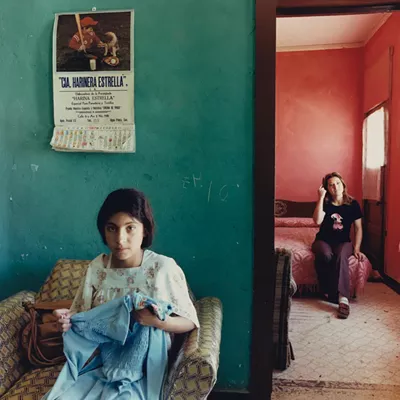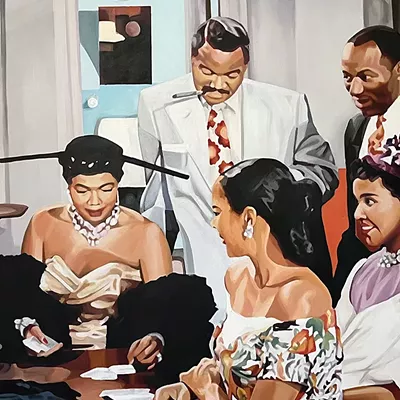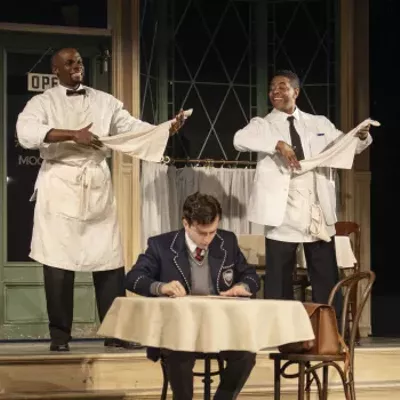The music was so beautiful, she says, it distracted her--momentarily--from the gorgeous tropical flowers and plants all around her and the views of the blue Pacific below.
"Oh, my gosh, I love it," she said to herself. The minute she got home, she and her husband, Chuck Koesters, turned on the computer to track down the piece for violin and piano. After some trouble, they found no fewer than 12 Mendelssohn sonatas.
"I listened to them all week, and I picked three."
Right away, Bunker, the longtime artistic director of Tucson's O-T-O Dance, set to work choreographing a new dance to her new favorite music. At one time, she would have set the piece on the pros in her troupe. But this was now, so she shaped it on her students at the University of Hawaii at Hilo, where she is a lecturer in dance. (She also teaches at Hawaii Community College, which shares a dance studio with the university.)
She called the three-sonata, three-part work "Impedimento."
"In its first genesis, it was a trio for women," she explains. Then, at a dance residency she held at the University of Texas at Dallas this spring, Bunker set it on a dozen dancers. Back in Hawaii, she tried it on a small army of 22, giving the hardest movements to her advanced students and the easiest to the beginners.
Finally, this weekend, at the O-T-O Dance concert Flying, Dance and Films III, Tucsonans can see it, in its fourth incarnation, as an octet for eight professional dancers (Staci Alexander, Kiona Brown, Briana Commins, Jennifer Dennison, Kailey Johnson, Sukie Keita, Aja Knaub and Julia Miller).
"With each new group of people, I say, 'Let's see what they do with it,'" explains Bunker. "It's been a fun adventure over several months.
"It starts out on a contemplative tone and builds to quick. The second section gets quicker, and the third section is even faster."
That increasing momentum could easily describe Bunker's peripatetic life over the last several years. For more than two decades, Bunker ran her company out of assorted studios in downtown Tucson. The troupe specializes in modern dance, but 17 years ago, Bunker and her dancers took to the air and mastered trapeze dancing. She and Koesters, the company's composer and videographer, lived in the remote desert northwest of town, as caretakers of Sanctuary Cove, and the local flora and fauna often made their way into their collaborative pieces.
But a few years back, they began gradually transplanting themselves to Hawaii, where they bought a house of their own. Ocean imagery crept into their dances and videos. They intended to continue to spend most of their time in Tucson, at least until their son graduated from high school, but that changed when Bunker was offered the university teaching position.
"It's working out really well," she says of their dual desert-island life, with an emphasis on island. "I like the change, being in a university and with the student dancers. It's unbelievable how many men I have doing aerial dance there. Dance and movement are in the culture. They take to dance easily. It's beautiful."
But she hasn't given up on her troupe in Tucson, nor her school.
"We come back in December and have a studio show. Then we come back for two months, in June and July, and do the summer school" and the June concert.
Dancer Knaub "runs the school for me," Bunker says. "We're in contact several times a week."
And the dancers helped out by contributing to this weekend's show. Knaub choreographed an aerial quartet, "Breathing Underwater," and former O-T-O dancer Johnson is bringing in a solo of her own, "Why Don't We?" It was no problem for Bunker to set three works of her own on local dancers over the last several weeks, she says. "We're into polishing the pieces now."
The concert at the UA's Stevie Eller Theatre intersperses the five dances with three short films celebrating movement. Now in its third year, the Flying and Films show this time also adds a third genre, live music, in the form of drumming by Tucson's Odaiko Sonora.
New York City filmmaker Jodi Kaplan has screened films in each of the previous concerts, and she comes back this year for a third outing. She'll show her newest cut of In the Blood, an experimental movie about the "choreography of boxing."
"Last year, it was a work in progress," Bunker explains. Now fully formed, its 12 minutes are divided into 12 fragments, mirroring the typical 12 rounds in a boxing match, exploring the "choreography of boxing."
Laura Lee Coles-Moster contributes the five-minute film Crow's Song. An artist who spearheads the interdisciplinary performance group Population of Noise in Vancouver, she's shot a film in her neighborhood about the "movement, light and sound" of birds, Bunker says. "It traces birds in different positions."
Koesters frequently splices his videos into Bunker's dances, but in this concert, he'll also show a film that stands alone. It's an homage to Rachel Rosenthal, whom Bunker calls the "mother of performance art. She began in the late '50s, out of the beat generation." In the film, "Her voice is overlaid with music. You see abstracted forms of people moving. Her voice is so wonderful, giving ideas and images."
Koesters also made a video backdrop for Knaub's "Breathing Underwater," picturing the rippling surface of a body of water. Danced by Keita, Brown, Olive Davis and Knaub herself, the work uses breathing difficulties as a poetic metaphor for life's suffocating patches, Bunker says.
Johnson, who now dances in New York, set her comic solo to the Beatles song, "Why Don't We Do It in the Road?" Performed last November at Jalopy Theater in Brooklyn, it's a "short, sweet take on sexual frustration," Bunker says.
Bunker's "Unfolding," a celebration of bat flight, includes a video Koesters shot of thousands of bats flying out of a Southern Arizona cave. An update on a piece from a year and half ago, the work will be danced by Miller, Dennison, Commins and Bunker herself.
Her new aerial dance, "Cry Salam," features 12 dancers in white--Brown, Keita and Knaub, along with nine student dancers who studied in the summer workshop--moving through the air on three trapezes.
"They're a little reminiscent of angels," Bunker says. "It's a prayer for peace."
The show won't end here in Tucson. Like Bunker and Koesters, it will travel back across the Pacific at the end of the summer. New dancers will give it new life.
"We'll present it in Hawaii in September," Bunker says, "at the university theater."










